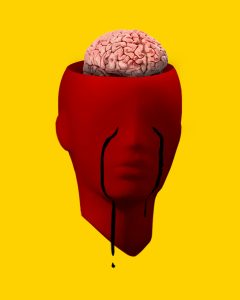The Connection Between Your Thoughts, Feelings, and Behaviors
 A friend walks past you on the street and doesn’t say hello. You immediately feel a pang of hurt and spend the rest of the day avoiding them. What just happened? It might seem like the event—your friend ignoring you—directly caused your feeling of hurt and your behavior of avoidance. But what if there was a hidden, crucial step in the middle of that process? This is the central insight of Cognitive Behavioral Therapy (CBT), and it’s a concept that can change your life: our thoughts, feelings, and behaviors are all part of a powerful, interconnected cycle.
A friend walks past you on the street and doesn’t say hello. You immediately feel a pang of hurt and spend the rest of the day avoiding them. What just happened? It might seem like the event—your friend ignoring you—directly caused your feeling of hurt and your behavior of avoidance. But what if there was a hidden, crucial step in the middle of that process? This is the central insight of Cognitive Behavioral Therapy (CBT), and it’s a concept that can change your life: our thoughts, feelings, and behaviors are all part of a powerful, interconnected cycle.
At Televero Health, we teach this model to our patients because it is the key to understanding why you feel the way you do and how you can start to change it. When you learn to see the connection between these three elements, you gain the power to intervene in the cycle and create better outcomes for yourself.
The Cognitive Triangle
The relationship between your thoughts, feelings, and behaviors is often illustrated as a triangle, with each point influencing the others. It’s not a one-way street; it’s a dynamic feedback loop.
Let’s break it down using our example:
- The Situation: A friend walks past you without saying hello.
- Your Thought: The first thing that happens is a thought, an interpretation of the event. It happens so fast you might not even notice it. Let’s say your automatic thought is, “She’s mad at me. I must have done something wrong.”
- Your Feeling: This thought directly creates an emotional response. Because you believe your friend is angry with you, you feel hurt, anxious, and rejected.
- Your Behavior: Your feelings then drive your actions. Because you feel hurt and anxious, you avoid your friend for the rest of the day and ruminate on all the things you might have done to upset her.
Now, notice how the behavior then feeds back into the thought. By avoiding your friend, you never get the chance to find out if your thought was actually true. Your avoidance reinforces your belief that she is mad at you, which makes you feel even more anxious. You are stuck in a negative loop.
The Power of a Different Thought
The most empowering part of this model is realizing that the thought is the leverage point. It’s the part of the cycle where you have the most power to intervene. What if, in that same situation, you had a different automatic thought?
- The Situation: A friend walks past you without saying hello.
- A Different Thought: “Wow, she must be really distracted or having a tough day. She didn’t even see me.”
- A Different Feeling: This thought leads to a completely different emotion. Instead of hurt and anxiety, you might feel concern or understanding.
- A Different Behavior: Because you feel concerned, your behavior is different. You might send her a text later that says, “Hey, I saw you earlier but you looked really preoccupied. Hope everything is okay!”
In this second scenario, the event was exactly the same. The only thing that changed was your initial thought, your interpretation. But that single change completely altered your emotional experience and your behavior, leading to a much healthier and more constructive outcome.
How to Use This Skill
This is the fundamental skill you will learn in many forms of therapy. It’s a three-step process:
- Notice the connection. Start to pay attention to the link between your feelings and the thoughts that came just before them. When you feel a strong negative emotion, ask yourself, “What was just going through my mind?”
- Catch your automatic thoughts. Learn to identify these quick, unexamined interpretations.
- Challenge and reframe. Ask yourself if your automatic thought is 100% true. Is there any other possible explanation? Try to come up with a more balanced, realistic alternative.
By practicing this skill, you are learning to get out of the passenger seat of your emotional life and into the driver’s seat. You are learning that while you can’t always control what happens to you, you have a powerful ability to choose how you respond.
Key Takeaways
- Your thoughts, feelings, and behaviors are all interconnected in a powerful cycle, often called the “cognitive triangle.”
- It is not external events, but your thoughts and interpretations of those events, that primarily determine how you feel.
- By learning to identify and challenge your automatic negative thoughts, you can change the entire cycle, leading to different feelings and behaviors.
- This skill empowers you to take control of your emotional responses and to build a more resilient mindset.
Ready to take the first step? We can help. Get started with Televero Health today.
